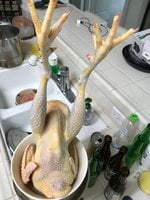I'd like to move to a purebred flock and am looking at Wyandottes. Has anyone dressed one of these out? I've butchered rangers, cornish cross, mixed breeds etc so I know this is not going to look like a store bird. What I'm asking is how the carcass size compares with other breeds - scrawny like an easter egger? That kind of thing.
I'm limiting myself to a bird with a tighter comb because winters can get pretty cold here. Brahmas are another option. Currently I have a part-Brahma rooster and a bunch of ranger hens. They do cross to make a nice bird but I'm hoping to move to a pure flock. Thoughts?
I'm limiting myself to a bird with a tighter comb because winters can get pretty cold here. Brahmas are another option. Currently I have a part-Brahma rooster and a bunch of ranger hens. They do cross to make a nice bird but I'm hoping to move to a pure flock. Thoughts?




